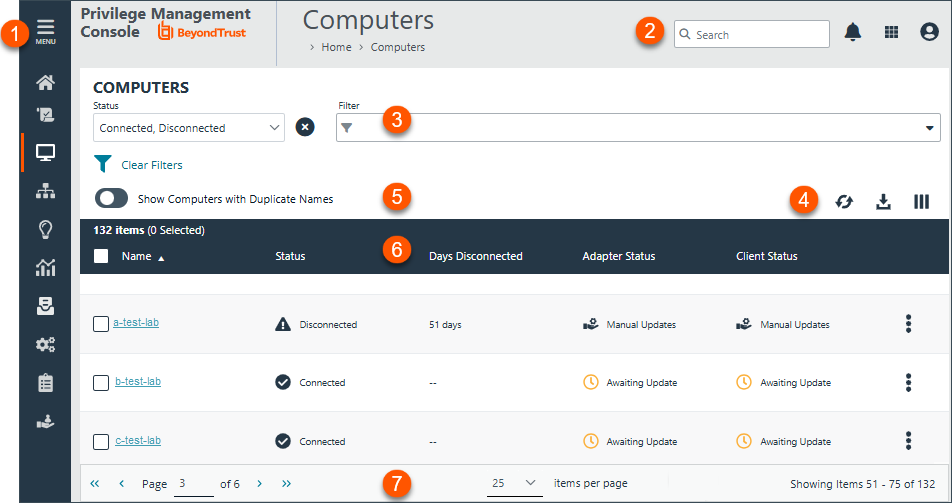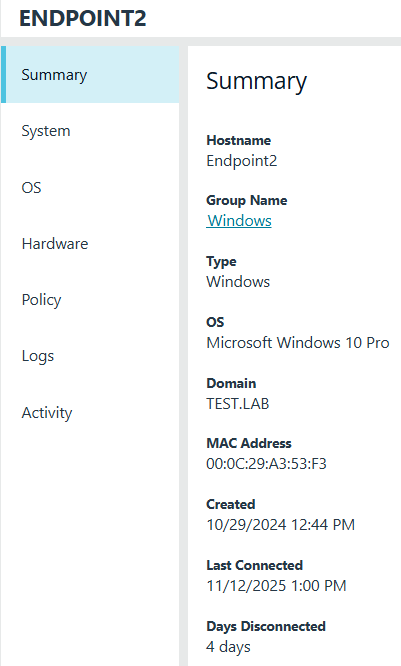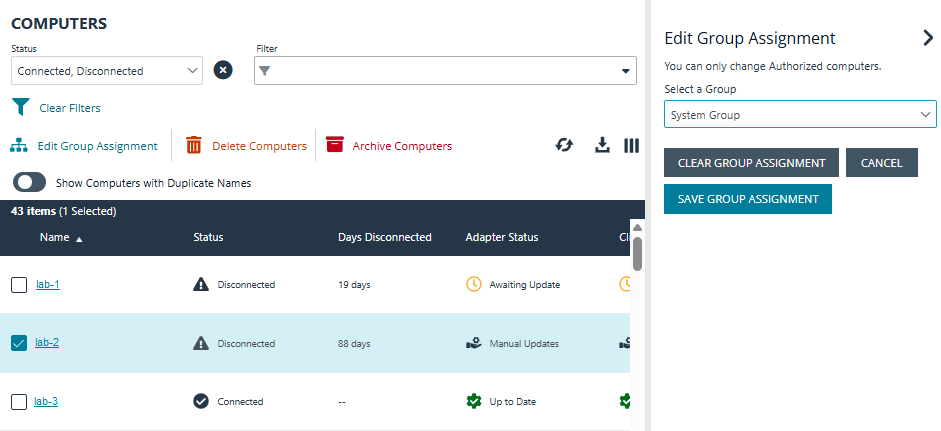Computers | EPM-WM Cloud
Use the Computers page to manage the computers (machines) in your organization.
The Computers page

- Left menu: Easy access to all pages in Endpoint Privilege Management, including the Home, Policies, Computers, Computer Groups, Management Rules, Analytics, Just-in-Time Access Management, Configuration, Auditing, and User Management pages.
- Header: Enter keywords to run a global search across computer groups, policies, computers, and users, view your notifications, change your site language, change your time zone, and log out of EPM for Windows and Mac.
- Filters: Select a filter to refine your results. Click Clear Filters to remove all filters from your results.
Available filters
- Name: Enter all or part of a policy name.
- Status: The state of the computer, Connected, Disconnected, or Archived.
- Disconnected for more than: Enter the number of days a computer is disconnected.
- Client Status: The status of the adapter install, such as Manual Updates, Awaiting Update, or Up to Date.
- Adapter Status: The status of the adapter install, such as Manual Updates, Awaiting Update, or Up to Date.
- Authorization State: The status of the computer, Authorized or Deactivated.
- Group Name: The group where the computer is a member.
- Assigned Policy: The name of the policy assigned to the computer.
- Current Applied Policy: The policy name and revision the computer is on.
- Policy Status: The state of the policy, such as Awaiting Latest Policy or On Latest Policy.
- Last Connected: The date the computer last checked in with .
- Package Manager: The version of Package Manager deployed to the computer.
- OS: The operating system and version.
- Domain: The domain where the computer resides.
- Created On: The date the computer was created.
- Archived for more than: Enter the number of days.
- System Type: Windows or Mac
- List options: Click
 to refresh the list,
to refresh the list, ![Download icon in [%=Products.PMAb%] SaaS.](https://files.readme.io/0409dc72778b865c649d6bd0fc9d6042351367b265e483c1fde9404b45346d8f-icon-download.png) to download the list to a .csv file, and
to download the list to a .csv file, and  to select which columns to display on the page.
to select which columns to display on the page. - Show Computers with Duplicate Names: Filter your computer list to only those with duplicate names.
- Computers list columns: Not all columns display in the image above.
Available columns
- Name: The computer name.
- Status: The state of the computer (Connected, Disconnected, or Archived).
- Days Disconnected: The number of days the computer has been disconnected from.
- Group Name: The group where the computer is a member.
- Adapter Status: The status of the adapter install, such as Manual Updates, Awaiting Update, or Up to Date.
- Client Status: The status of the client install, such as Manual Updates, Awaiting Update, or Up to Date.
- Current Applied Policy: The policy name and revision the computer is on.
- Assigned Policy: The name of the policy assigned to the computer.
- Policy Status: The state of the policy, such as Awaiting Latest Policy or On Latest Policy.
- Computer ID: The ID for the computer.
- Last Connected: The date the computer last checked in with EPM.
- Client: The version of the client deployed to the computer.
- Adapter: The version of the adapter deployed to the computer.
- Package Manager: The version of Package Manager deployed to the computer.
- OS: The operating system and version.
- Domain: The domain where the computer resides.
- Created On: The date the computer was created.
- Authorization State: The status of the computer, Authorized or Deactivated.
- Archived On: The date the computer was archived.
- System Type: Windows or Mac operating system
- List navigation options: Navigate the Computers list by moving forward or backward and setting the number of items to display per page.
View a computer's details
To ensure computers are up to date and running properly, you can view details on the computer which include hardware and operating system information, policy status, and logging information.
- From the left menu, click
 .
.
The Computers page displays.
- Locate and select the computer you want to view.
- Click
 > View Computer Details.
> View Computer Details.
The computer details display, including a summary, the system, the OS, hardware, policy, logs, and activity.

Download a computer's logs
You can view and download logs to track activities between the computer and EPM. There are two types of logs:
- Computer: Records all communication between EPM and the computer.
- Command: Records the commands sent to the computer. The log information includes the command sent and whether the command was received by the computer.
- From the left menu, click
 .
.
The Computers page displays.
- Locate and select the computer you want to view.
- Click
 > View Computer Details.
> View Computer Details.
The computer details pages display. - In the left menu, click Logs.
The Logs page displays. - Select the type of log you want to download (Computer or Command).
- Click Request Logs.
The log request is sent. - To gather recent activity or if there are no logs, click Request Logs.
Edit a computer's group assignment
During the adapter install, computers are automatically assigned to a group with a status of Authorized. If a group ID is not assigned at installation, the default group is used.
You can change the group assignment if policy requirements change for a computer.
- From the left menu, click
 .
.
The Computers page displays.
-
Locate and select the computer you want to edit.
-
Click
 > Edit Group Assignment.
> Edit Group Assignment.
The Edit Group Assignment panel displays.
-
Optionally, click Clear Group Assignment to remove the computer from a group assignment.
-
Optionally, select a new group assignment from the Select a Group drop-down list.
-
Click Save Group Assignment.
The assignment saves.
Check a policy status
If a computer's status is Awaiting Latest Policy, you can view more information about the policy on the computer's details page'sPolicy tab. The collected metrics include the current policy applied and the version.
- From the left menu, click
 .
.
The Computers page displays.
- Locate and select the computer you want to view.
- Click
 > View Computer Details.
> View Computer Details.
The computer details pages display. - In the left menu, click Policy.
The Policy page displays with details about the status.
Update computer details
- From the left menu, click
 .
.
The Computers page displays.
- Locate and select the computer you want to view.
- Click
 > Update Computer Details.
> Update Computer Details.
A confirmation message displays. - Click Request Update.
EPM for Windows and Mac sends an update request, and the details refresh. Note there may be a delay of a few hours.
View a computer's analytics
- From the left menu, click
 .
.
The Computers page displays.
- Locate and select the computer you want to view.
- Click
 > View Computer Details.
> View Computer Details.
The computer details pages display. - In the left menu, click View Analytics.
The Analytics page opens and displays the Events tab, where you can view all events and their details.
Manually archive one or more computers
- From the left menu, click
 .
.
The Computers page displays.
- Locate and select the computers you want to archive.
- Click Archive Computers.
A confirmation message displays. - Click Archive Computer.
A request is sent to archive the computer(s), and the system updates. You can view the archived computers
View archived computers
- From the left menu, click
 .
.
The Computers page displays.
- In the Status drop-down, select Archived.
The Computers list updates with archived computers.
Delete a computer
WARNING
Deleting a computer is an unrecoverable operation.
- From the left menu, click
 .
.
The Computers page displays.
- Locate the computer you want to delete from the list.
- Click
 > Delete Computer .
> Delete Computer .
A confirmation message displays. - Click Delete Computer.
The computer is deleted from your EPM for Windows and Mac application.
Updated 17 days ago
